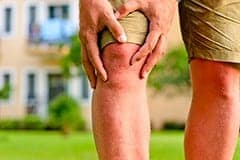Nearly a third of Americans will develop osteoarthritis of the knee before age 70. With no “cure” beside knee replacement on the horizon for this painful joint condition, relief often has to come from pain pills. Assistive devices such as wedge insoles are often prescribed as a less drastic, side effect-free treatment option. But do they really work? A research review published today in JAMA indicates that these shoe inserts do little—if anything—to relieve arthritis pain.
The review looked at the use of lateral wedge insoles for medial knee osteoarthritis, which affects the inner part of the knee. Lateral insoles are thicker at the outer edge of the foot. Slightly tilting the foot is thought to reduce the load on the inner knee joint.
Walking directs more force to the inside part of the knee (the medial aspect) than the outside part (the lateral aspect). The medial compartment is where osteoarthritis usually appears first. “A lateral wedge insole is intended to reduce pressure transmitted through the lower leg to the medial compartment of the knee during walking,” explains Dr. Robert Shmerling, clinical chief in the Division of Rheumatology at Beth Israel Deaconess Medical Center, and associate professor of medicine at Harvard Medical School.
To see whether lateral wedge insoles actually relieve arthritis pain, an international team of researchers evaluated the results of 12 different shoe-based clinical trials that included a total of 885 participants. Trials comparing the lateral wedge insole to a neutral insole didn’t find a significant improvement in pain.
The findings echo new osteoarthritis treatment guidelines released by the American Academy of Orthopaedic Surgeons (AAOS) in May. Based on current research, the AAOS said it couldn’t recommend lateral wedge insoles for people with medial knee osteoarthritis.
Is it worth wearing insoles?
Doctors who recommend these inserts for their patients may want to re-evaluate their decision based on the most current research, says Dr. Shmerling. Yet you don’t need to toss out lateral wedge insoles if they’ve worked for you, because everyone’s response to treatment can be different. “I think it makes sense to recommend insoles on a case-by-case basis, because even though the average response was no different between wedge insole users and non-users, individual response can vary,” Dr. Shmerling says.
You just might not want to splurge on the priciest options at first. The cost of lateral wedge insoles can range from $10 for ones you buy off the shelf at your local pharmacy or shoe store to $500 for a pair of custom-made insoles your podiatrist or orthopedist orders for you. “Considering the results of this study, I think it’s hard to justify a big investment in wedge insoles solely to treat knee pain from osteoarthritis,” Dr. Shmerling says. “My advice would be to go with inexpensive insoles, and if you’re no better, and if nothing else is working, you could consider seeing a podiatrist or orthotist for higher-end options.”
An alternative to inserts is using a cane to improve your stability. So can buying the right shoes. There is evidence that wearing flat-heeled, flexible shoes—especially ones that mimic the natural movement of walking barefoot—may do more to slow knee osteoarthritis than any insert you stick inside them.


